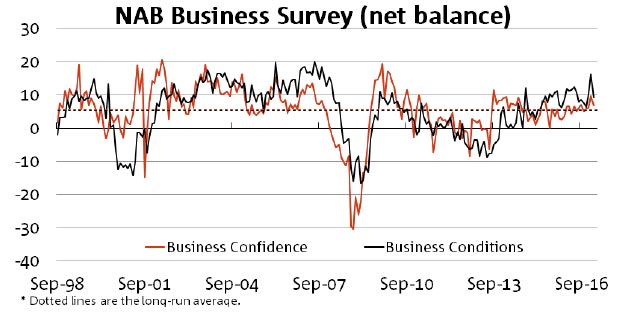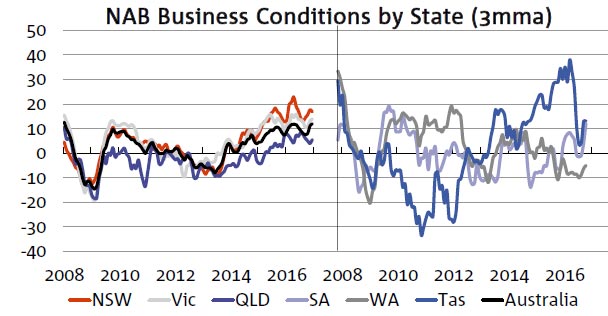The February NAB Business Survey gave back the surprisingly strong gains seen in the previous month. But the overall results are still quite positive, and not uniform across the states.
Some payback was flagged in last month’s Survey as temporary factors were thought to have been behind much of the spike in both business conditions and confidence. However, despite the pull-back, both of these indicators remain at levels consistent with solid business activity in the near-term, and are higher than through much of H2 2016.
The business conditions index dropped by 7 points in February, more than unwinding the 6 point jump in January, to be at +9 index points – still above the series long-run average. The fall in business conditions was reflected across all three components of the index (trading conditions/sales, profitability and employment), although the bulk of the deterioration seems to have come from sales, which is now noticeably weaker than it was back in December. Profitability did not spike with the other components in January and saw only a small moderation. Employment also weakened slightly, but is still well up on December levels – an strong outcome and indicative of a strengthening underlying trend (which has been more encouraging than ABS labour market statistics). By industry, we remain concerned about retail conditions, but all other industries (including mining) recorded positive business conditions in February. Additionally, conditions are looking good across most states, with WA the main exception. Cost price measures in the Survey were mixed, although labour costs held up and retail prices accelerated (but are still relatively soft).
NAB’s Business confidence index dropped back a little as well in the month, but is still suggesting that business sentiment remains relatively upbeat – consistent with the overall tone seen in financial markets. The business confidence index fell 3 points to +7 index points in February, which is slightly above the series long-run average. Other indicators were reasonably solid as well, with capacity utilisation rates holding up, consistent with a solid (albeit easing) read on capital expenditure. Forward orders, however, continue to look relatively muted.
A drop in activity indicators had been anticipated for the February NAB Monthly Business Survey, meaning these results do not fundamentally change NAB’s outlook for the economy. Indeed, business conditions are still at quite lofty levels, consistent with our expectation for the economy to enjoy solid rates of growth in the near-term. There are, however, still some points of concern such as the persistent weakness evident in retail conditions, which warrant close monitoring. Additionally, it is the longer-term growth picture that is more concerning, particularly as the contribution from LNG exports, temporarily higher commodity prices and the residential construction boom fade, putting pressure on the labour market. However, the RBA is increasingly putting emphasis on financial stability concerns, which is likely to impact the response of monetary policy.
By state, outcomes were quite mixed in this month’s Survey, although most states are generally looking quite solid. NSW and WA saw the largest falls in business conditions, down 6 and 9 points respectively, although conditions in NSW still look quite good at +14 index points. WA on the other hand was very weak at -11 index points, the only state to be negative, despite positive conditions reported nationally in the mining industry. In contrast, SA saw a very large increase in conditions during the month. Looking through the monthly volatility, NSW maintains the highest conditions in trend terms (+17), followed by Victoria (+14). Meanwhile, WA is weakest (-5), followed by Qld (+5). In terms of confidence, Queensland is best in trend terms (see p8 for details).


